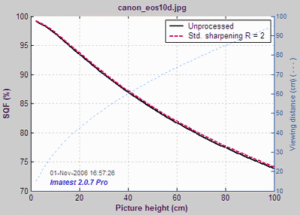MTF is a measure of device or system sharpness and is indirectly related to the perceived sharpness when a display or print is viewed. A more refined estimate of perceived sharpness must include assumptions about the display size, viewing distance (typically proportional to the square root of display or print height), and the human visual system (the human eye’s Contrast Sensitivity Function [CSF]). Such a formula, called Subjective Quality Factor (SQF) developed by Kodak scientists in 1972, is included in Imatest. It has been verified and used inside Kodak and Polaroid, but it has remained obscure until now because it was difficult to calculate. Its only significant public exposure has been in Popular Photography lens tests. Imatest can also calculate a closely-related measurement called Acutance, developed by the Camera Phone Image Quality (CPIQ) initiative, and defined in the CPIQ 2.0 Specification document.
A portion of the Imatest SFR SQF (Figure 1) for the EOS-10D is shown on the right. SQF is plotted as a function of display size. Viewing distance (pale blue dashes, with scale on the right) is assumed to be proportional to the square root of picture height. SQF is shown with and without standardized sharpening. SQF is extremely sensitive to sharpening, as you would expect since sharpening is applied to improve perceptual sharpness.
Figure 1. SQF as a function of picture height
Table 1 compares SQF for the EOS-10D with the MTF50.
Table 1. Comparison of SQF for EOS-10D and MTF
|
MTF50 |
Corresponding print height for the EOS-10D |
SQF |
Quality level |
|
150 |
8.9 inches = 22.6 cm |
93 |
Excellent—Extremely sharp. |
|
110 |
12.1 inches = 30.8 cm |
90 |
Very good |
|
80 |
16.7 inches = 42.4 cm |
86 |
Good—Very good at normal viewing distance for a print of this size, but visibly soft on close examination. |
An interpretation of SQF is give here. Generally, 90-100 is considered excellent, 80-90 is very good, 70-80 is good, and 60-70 is fair. These numbers (which may be changed as more data becomes available) are the result of “normal” observers viewing prints at normal distances (e.g., 30-34 cm (12-13 inches) for 10-cm- (4 inches) high prints). The judgments in the table above are a bit more stringent—the result of critical examination by a serious photographer. They correspond more closely to the normal interpretation of SQF when the viewing distance is proportional to the cube root of print height (SQF = 90, 86, and 80, respectively); i.e., prints are examined more closely than the standard square root assumption.
An SQF peak over about 105 may indicate oversharpening (strong halos near edges), which can degrade image quality. SQF measurements are more valid when oversharpening is removed, which is accomplished with standardized sharpening.


